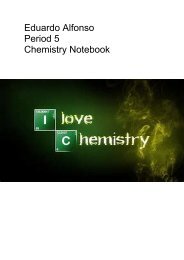Create successful ePaper yourself
Turn your PDF publications into a flip-book with our unique Google optimized e-Paper software.
• Increase in kinetic energy will result in an increase in temperature<br />
• At any given temperature, the particles of all substances regardless of physical state will<br />
have the same average kinetic energy<br />
• The average kinetic energy of the particles in a substance is directly correlated to the<br />
temperature of the substance<br />
• Molecules at a higher temperature have a wider range of kinetic energies<br />
• Absolute zero ( 0 K or -273*C) is the temperature at which theoretically, the motion of<br />
all particles stops . It is in no way possible for a temperature to be lower than absolute<br />
zero, as that is the lowest that it is possible to go<br />
• The kelvin temperature scale is proportional to the average kinetic energy of the particles<br />
of the substance<br />
• The effects of temperature on particle motion in liquids and solids are more complex than<br />
those in gas<br />
• There is a key difference between the particles in a gas and those in a liguid, that being<br />
that the particles in a gas there is no attraction between the particles within them<br />
• The particles within a liquid ARE attracted to each other , which keeps the particles<br />
within the liquid close together, thus why liquids have a definitive volume<br />
• Liquids are much more dense than gasses, as the intermolecular attractions reduce the<br />
amount of space between the particles in a liquid where as those in a solid are much<br />
farther spread apart<br />
• Increasing the pressure on a liquid has little to no effect on its volume<br />
• The same is true for solids ^<br />
• Vaporization- the conversion of a liquid to a gas or vapor<br />
• When this conversion occurs at the surface of a liquid that is not boiling it is referred to<br />
as evaporation<br />
• The majority of the molecules in a liquid don’t have enough kinetic energy to overcome<br />
the attractive forces and escape into the gaseous state<br />
• Heating a liquid will cause the average kinetic energy of a particle to increase therefore a<br />
liquid will evaporate faster when heated<br />
• The particles with the highest kinetic energy will escape first , leaving the ones with less<br />
energy lowering the average kinetic energy<br />
• Evaporation is a cooling process, as the liquids temperature decreases as soon as<br />
evaporation starts to take place<br />
• Vapor pressure is a measure of the force exerted by a gas above a liquid<br />
• In a system at constant vapor pressure, a dynamic equilibrium exists between the vapor<br />
and the liquid. The system is in the equilibrium because the rate of evaporation of liquid<br />
equals the rate of condensation of vapor<br />
• Moisture on the walls of the container is a goof sign that the equilibrium has been<br />
established<br />
• A liquid that is volatile is a liquid that evaporates with ease<br />
• When studying gasses it is important to relate measured values to standards<br />
122



